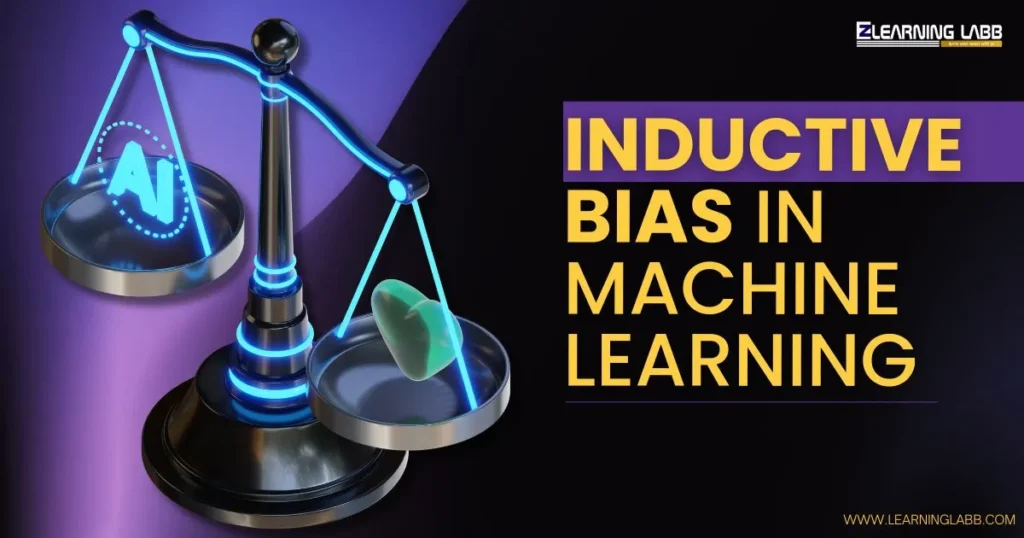Inductive Bias in Machine Learning: To understand how machines make predictions on data they’ve never seen, we need to talk about inductive bias in machine learning. In simple terms, it refers to the assumptions a learning algorithm makes to generalise from the training data to unseen situations. Since data is never complete, a model must fill in the blanks, and it does so based on its inductive bias.
Let me explain it a bit more simply, when you assume that the sun will rise tomorrow just because it rose today, you are showing a form of inductive reasoning. Similarly, in machine learning, a model trained on certain samples assumes that similar patterns will exist in future data. That assumption, or belief about data, is what we call inductive bias.
Without this built-in guidance, a model would have no clue how to act beyond its training data. This is why machine learning inductive bias isn’t just a technical term, it’s a core idea that makes machine learning work.
Why Is Inductive Bias Important?
Now that we know what inductive bias is, let’s ask the big question, why is inductive bias important? Simply put, it’s what allows a model to learn effectively. Without it, the model would either memorise the training data or fail to identify any useful patterns at all.
If a model is trying to classify emails as spam or not, it needs to rely on certain patterns, maybe the frequency of specific keywords, or unusual punctuation. These patterns form a structure, and the model assumes these patterns matter. That structure is the bias it brings to the learning process.
Another reason inductive bias in machine learning matters is because it helps prevent overfitting. Overfitting happens when a model is too closely tailored to the training data and fails on new inputs. A good inductive bias provides just enough structure to guide the model without letting it go overboard.
“Inductive bias is the direction you give your model — without it, you’re just fitting lines in the dark.” — Kriti Kaushik, Data Scientist & Trainer at ZELL
So, a well-designed bias acts like a teacher guiding a student, helping them understand not just what’s in the book but also how to think when they see something new. Now that you know why is inductive bias important, let’s get to the next part.

Types of Inductive Bias in Machine Learning
Different algorithms rely on different types of biases to make decisions. Understanding these types of inductive bias in machine learning can help you choose the right algorithm for your problem.
1. Language Bias
Language bias limits the form of the hypotheses that a model can learn. For example, a linear regression model is biased toward linear relationships. It won’t even attempt to learn curves or non-linear patterns. This can be useful if the actual relationship is linear, but problematic if it’s not.
2. Search Bias
Search bias defines the path an algorithm takes when exploring possible models. Decision tree algorithms like ID3 or C4.5, for instance, tend to favour shorter trees. This bias helps make models more interpretable, but it might overlook complex solutions that perform better.
3. Parameter Bias
Some models prefer smaller or simpler parameter values, based on their configuration. This is often controlled by regularisation techniques. For example, in Lasso regression, the model is biased toward solutions with fewer non-zero weights. This helps reduce overfitting and keeps models efficient.
4. Heuristic Bias
This bias is about using strategies based on experience or trial-and-error. Heuristic bias is common in algorithms where rules of thumb guide the learning process. Reinforcement learning, for instance, uses heuristic strategies to navigate unknown environments.
5. Prior Probability Bias
Used in probabilistic models like Bayesian networks, this bias comes from assigning prior beliefs before seeing any data. As data accumulates, these priors get updated. It’s a controlled way of learning from both assumptions and real evidence.
Each of these machine learning inductive bias types has strengths and weaknesses. Knowing which one your algorithm uses helps you understand its limits and possibilities.
How Inductive Bias Is Used?
Let’s look at a few everyday scenarios to see how machine learning inductive bias makes a difference.
1. Spam Filters
Spam detection models often assume that certain keywords, like “free”, “win”, or “urgent”, are associated with spam emails. This is a kind of language bias. It works well in most cases, although clever spammers constantly try to exploit it.
2. Stock Market Predictions
When analysts use linear models to predict stock prices, they are assuming price movements follow a straight-line trend. That’s a form of parameter and language bias. However, the market is influenced by countless factors, so this bias may lead to oversimplification.
3. Face Recognition
Convolutional Neural Networks (CNNs) are effective because they assume nearby pixels are related. This spatial bias allows them to identify faces, objects, and scenes with remarkable accuracy. Without this bias, CNNs wouldn’t be able to learn meaningful visual features.
In all these examples, the model’s success or failure depends heavily on whether its bias aligns with the real-world problem. This is exactly why understanding inductive bias in machine learning is important for both practitioners and learners.

Inductive bias and how to learn about it?
If you’re just stepping into the field or planning a shift in career, you might ask: Why should I care about this as a learner or professional?
Here’s the answer: The more you understand how models learn, the better you’ll be at choosing the right tools for the job. And knowing what is inductive bias in machine learning helps you avoid blind spots in your workflow.
If you’re learning from scratch, consider joining structured programmes that teach not only algorithms but also the thinking behind them. Zenoffi E-Learning Labb offers excellent training through its:
- Data Science Courses in Bangalore with hands-on projects and real-world use-cases
- Best Data Science Courses for beginners and working professionals
- Data Analytics Training that focuses on tools like Python, SQL, Tableau, Excel, and more
These courses are designed for practical learning and yes, they cover inductive bias, bias-variance trade-offs, regularisation, and everything that makes real-world models work.
Key Points
Let’s wrap up the key points to remember:
- Inductive bias in machine learning is the assumption a model uses to generalise from training data to unseen data.
- Without this bias, models would either overfit or fail to learn anything meaningful.
- The types of inductive bias in machine learning include language, search, parameter, heuristic, and prior probability biases.
- Every model you choose has its own built-in bias, knowing that helps you make smarter decisions.
- Learning about these concepts adds real depth to your career in data analytics or data science.
On A Final Note…
Inductive bias in machine learning is not just about feeding data, it’s about knowing how your algorithm interprets it and why it reacts in certain ways. This is one of those invisible forces that separate average models from impactful ones. If you’re aiming to grow in the field of data or AI, make sure you don’t skip these foundational ideas.
As ZELL trainer Riyaz Bagban wisely said:
“The algorithm is just a tool. Its true power comes from how you guide it. That guidance, that’s inductive bias.”
If you’re ready to learn more, explore the hands-on, mentor-driven programs at Zenoffi. Your journey into machine learning doesn’t have to be guesswork, let it be guided by the right biases.

Frequently Asked Questions on Inductive Bias in Machine Learning
What is inductive bias in machine learning?
Inductive bias refers to the assumptions made by a machine learning algorithm to make predictions on unseen data.
Why is inductive bias important?
It’s important because it guides how a model generalises from training data to future predictions.
Are there different types of inductive bias?
Yes. Common types include language bias, search bias, heuristic bias, parameter bias, and prior probability bias.
How can inductive bias affect model accuracy?
If the bias matches the problem, the model performs well. If not, it may miss important patterns.
Can I learn about inductive bias in a course?
Absolutely. Zenoffi E-Learning Labb offers data analytics training and data science courses in Bangalore that cover these and many other topics in depth.





